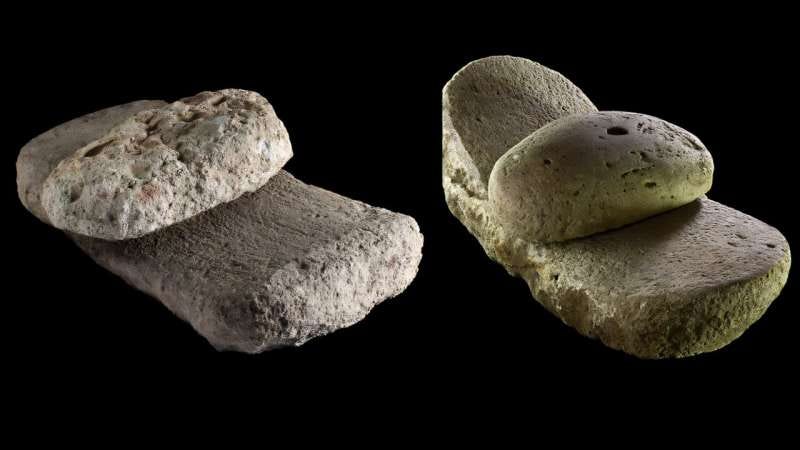🧐 Ancient Beat #147: Bones, stones, and treasure
Welcome, friends — this is issue #147 of Ancient Beat. Here’s the latest ancient news.👇
🗞 Ancient News: Top 5
2,600-Year-Old Treasure-Filled Pottery Vessel Discovered in Karnak, Egypt — Archaeologists have unearthed a small, intact pottery vessel in the Karnak temple complex in Egypt, dating back approximately 2,600 years to the onset of the Twenty-Sixth Dynasty. Inside, they found a collection of well-preserved artifacts, including gold and metal rings, small gold amulets — among them a triad statue representing the deities Amun, Mut, and Khonsu — a metal brooch, and numerous beads, some gold-plated or gilded. These items provide insight into the craftsmanship and religious practices of the period. The discovery was made in the complex's northwestern sector, where ongoing excavations have also revealed large mudbrick structures believed to have served as workshops or storage areas linked to the temple's operations.
Bones of Innovation: How Early Hominins Pioneered Toolmaking 1.5 Million Years Ago — A recent study from Olduvai Gorge, Tanzania, reveals that early hominins systematically crafted bone tools 1.5 million years ago, predating previous estimates by a million years. Archaeologists uncovered 27 bone tools made primarily from elephant and hippopotamus limb bones. These artifacts exhibit intentional knapping techniques, similar to stone tool production, indicating advanced cognitive abilities. The tools' design suggests they were used for heavy-duty tasks, possibly including butchering large animals. This discovery highlights early humans' adaptability and innovation in utilizing diverse materials for toolmaking.
Artificial Intelligence Finds 5,000-Year-Old Civilization Beneath Dubai Desert — Recent advancements in artificial intelligence and Synthetic Aperture Radar (SAR) technology have led to the discovery of a 5,000-year-old civilization beneath the Dubai desert. This buried city includes ancient settlements and communication networks, such as roads and infrastructure, offering insights into life in extreme environments. SAR technology provides high-resolution images capable of penetrating natural barriers like sand, vegetation, and ice, allowing researchers to detect structures without excavation. By analyzing SAR data with machine learning algorithms, patterns indicative of human-built structures were identified, revolutionizing archaeological exploration. This approach has also been applied in regions like Mongolia to trace historical trade routes, including the Silk Road.
Time and Life Cycles Reflected in the Grinding Stones of Europe's Earliest Neolithic Communities — Research on grinding tools from ritual sites in Goseck and Sömmerda, Germany, dating to 4900–4650 BCE, indicates these tools held significant symbolic value. The tools, used primarily by women to process cereals, were found buried in pairs, oriented east to west, and ranged from nearly new to completely worn out. This deliberate selection and arrangement suggest a representation of life cycles — birth, life, and death — mirroring human existence, nature, and settlement patterns. The careful production, use, and deposition of these tools reflect the deep social and temporal concepts held by these early agricultural communities.
Massive Network of Ancient Canals Mapped in Mesopotamia — Near the ancient Sumerian city of Eridu in southern Iraq, researchers have mapped over 4,000 irrigation canals. Eridu, inhabited from the 6th through the 1st millennium BCE, is traditionally considered the world's oldest city. The canal network includes approximately 200 primary canals, some extending up to 5.5 miles, and thousands of smaller channels that distributed water to agricultural fields. This extensive system supported around 700 farmsteads, indicating a highly organized agricultural landscape. The city's decline in the 1st millennium BCE is attributed to the Euphrates River altering its course away from Eridu, leading to its abandonment.
That’s it for the free Top 5! If you’re a free subscriber, sign up for the paid plan for another 26 discoveries and 3 recommended pieces of content covering menhirs, cinnabar, fire making, and Shakespeare.
Until next time, thanks for joining me!
-James
Twitter: @jamesofthedrum
P.S. Here’s my Buy Me A Coffee link if you’d like to support my efforts with a donation.
P.P.S. If you want access to the paid version but it’s a little too steep for you right now, just email me — I want this to be accessible.
P.P.P.S. Paid members, read on!



